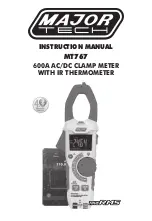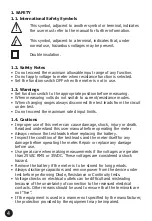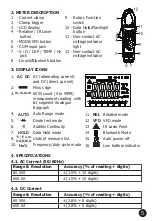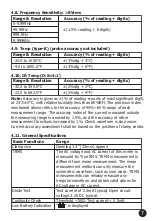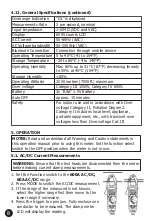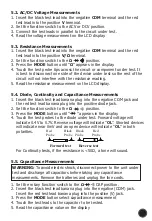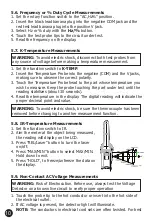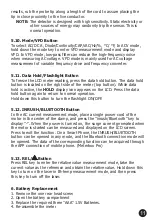
10
5.5. Capacitance Measurements
1. Set the rotary function switch to the
Ω
CAP position.
2. Insert the black test lead banana plug into the negative (COM) jack.
Insert the red test lead banana plug into the positive (V) jack.
3. Press the
MODE
button select capacitance measurement
4. Touch the test leads to the capacitor to be tested.
5. Read the capacitance value in the display
WARNING:
To avoid electric shock, disconnect power to the unit under
test and discharge all capacitors before taking any capacitance
measurements. Remove the batteries and unplug the line cords.
5.6. Frequency or % Duty Cycle Measurements
1. Set the rotary function switch to the "AC,Hz%" position.
2. Insert the black lead banana plug into the negative COM jack and the
red test lead banana plug into the positive V jack.
3. Select Hz or % duty with the
Hz/%
button.
4. Touch the test probe tips to the circuit under test.
5. Read the frequency on the display.
5.4. Diode, Continuity and Capacitance Measurements
1. Insert the black test lead banana plug into the negative
COM
jack and
the red test lead banana plug into the positive diode jack.
2. Turn the rotary switch to the
Ω
CAP position.
3. Press the
MODE
button until "
" appears in the display.
4. Touch the test probes to the diode under test. Forward voltage will
indicate 0.4V to 0.7V. Reverse voltage will indicate "
OL
". Shorted devices
will indicate near 0mV and an open device will indicate "
OL
" in both
polarities.
For Continuity tests, if the resistance is < 50Ω, a tone will sound.
Red Black Black Red
Probe Probe Probe Probe
Forward test Reverse test
5.6. Frequency or % Duty Cycle Measurements
1. Set the rotary function switch to the "AC,Hz%" position.
2. Insert the black lead banana plug into the negative COM jack and the
red test lead banana plug into the positive V jack.
3. Select Hz or % duty with the
Hz/%
button.
4. Touch the test probe tips to the circuit under test.
5. Read the frequency on the display.
5.7. K-Temperature Measurements
1. Set the function switch to
K-TEMP
.
2. Insert the Temperature Probe into the negative (COM) and the V jacks,
making sure to observe the correct polarity.
3. Touch the Temperature Probe head to the part whose temperature you
wish to measure. Keep the probe touching the part under test until the
reading stabilizes (about 30 seconds).
4. Read the temperature in the display. The digital reading will indicate the
proper decimal point and value.
WARNING:
To avoid electric shock, disconnect both test probes from
any source of voltage before making a temperature measurement.
WARNING:
To avoid electric shock, be sure the thermocouple has been
removed before changing to another measurement function.
5.8. IR-Temperature Measurements
1. Set the function switch to IR.
2. Aim the meter at the object being measured,
the reading will display on the LCD.
3. Press "REL/Laser" button to turn the laser
on/off.
4. Press "MAX/MIN" button to select MAX/MIN.
Hold down to exit.
5. Press "HOLD", to freeze/unfreeze the data on
the display.
5.9. Non-Contact AC Voltage Measurements
1. Touch the probe tip to the hot conductor or insert into the hot side of
the electrical outlet.
2. If AC voltage is present, the detector light will illuminate.
NOTE:
The conductors in electrical cord sets are often twisted. For best
WARNING:
Risk of Electrocution. Before use, always test the Voltage
Detector on a known live circuit to verify proper operation
Содержание MT767
Страница 1: ...MT767 600A AC DC CLAMP METER WITH IR THERMOMETER INSTRUCTION MANUAL...
Страница 2: ...2...

